sorry
out of stock
WT -419
0.5W / 2 W , water resistant (to IP52) 40 Ch UHF CB
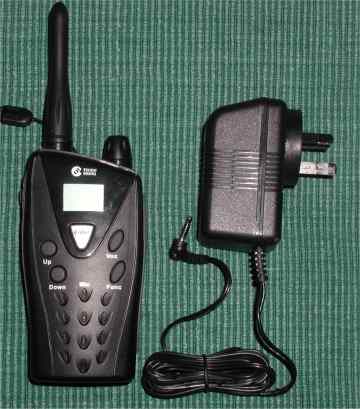
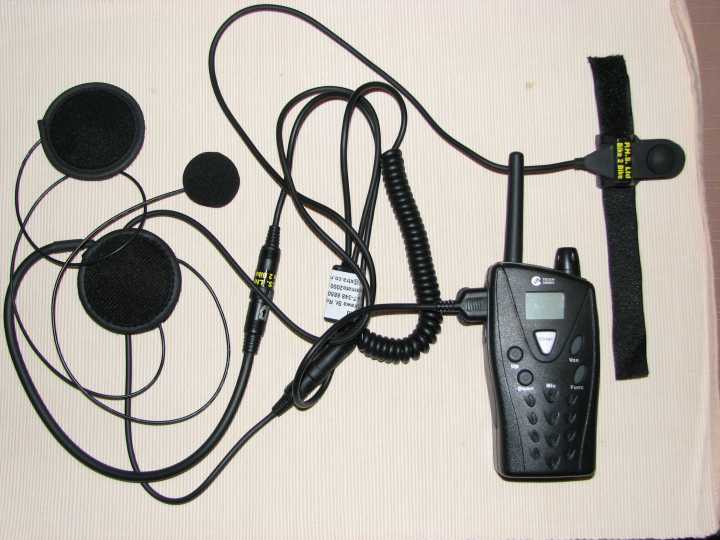
WT419 and
charger
WT419 and motorcycle headset/PTT
The WT-419 is a UHF CB handheld
manufactured by Tsuen Shing electronics in Honk Kong
that is ideal for motorcycle to motorcycle
communications or use in the outdoor environment. It is a 2 Watt RF output UHF
CB 40channel radio with
CTCSS capability, repeater function for all those range enhancing repeaters, key
lock ,so you can stuff it in to your jacket pocket and not have it jump to
another channel , A great feature termed "power off" function ( turns it self off
after a user definable time ( in hours) so make sure this time duration setting exceeds your
ride duration !! ) Vox capable with three levels of sensitivity
(but I'm a very disappointed at its very slow attack time) . Selectable RF
output power of 500 mW or 2W for that extra required range. The Radio
comes supplied with a charger and 4 rechargeable 1600
mAh
NOTE: due to the variation in performance of NiMiH batteries the batteries will not have a warranty
we are tempted to sell the radio without rechargeable batteries !
NiMih batteries , and an earphone/mic , although there is no reason you cant use standard AA alkaline batteries if you
had to ,we advise that if you are going hunting in
the bush you take a spare set of four AA alkaline batteries in case your rechargeable
ones go flat ! .
We often have people ringing up grizzling that the batteries
wont hold their charge , We always get the system back to check and find the
user has been running on High power and expecting the radio to run all day with
normal use , The radio will run all day with normal ( see the manual
specifications of suggested receive transmitt and standby times) use on
1600ma cells and set to 0.5W rf output , However if you are going to
run the radio on high power 2W Rf out then the cells are only going to last
a quarter of the time they last on 0.5 W, At 2W ,during transmit, the
radio is now consuming 4 times more energy per unit time , from the battery than
on 0.5 W transmit . .. Remember the handbook says a 13Hr charge for 1600mA
cells ,this is governed by the maximum current the radio charger will supply to
the batteries . If you are using 2500mA cells, then they will need a lot longer
to charge, at least another 7 hrs ! if this is not suitable and you
need to use the radio before this charging time then I suggest you purchase one
of the fast chargers from Dick smith, Jaycar , Altronics etc etc ,, Remeber also
that NiMH cells have a high self disharge rate compared to other cells
ie Alkaline, and dont be surprised that if the radio is put
away fully charged and pulled out a month later the cells will be completely
flat and need a recharge this is an undesirable feature of
NiMH system.
Never try and charge Alkaline/NiCad/Carbon
Zinc batteries in this radio, you will stuff the radio and burst the
batteries and perhaps injure yourself and neither is covered by
warranty !
WARNING : Be careful when you are
using it on a motorcycle headset or external earphone , this radio has
been modified to our specifications and it can be very loud in your ear using a
headset , don't turn it up loud when you first turn it on or it will blow
out your ears or possibly damage the earspeakers , and neither problem is
covered under the warranty! The connections for this radio's headset
are, 2.5mm stereo headset, plug tip is mic, ring is speaker
and sleeve common. 3.5mm mono plug for PTT switch ( 3.5mm stereo
plug for external battery charger )
The radio is also water and dust proof to standard IP52
(not IP54 ) which is
good for the motorcycle environment .This means it will be ok in a shower of
rain however please note that IP52 is NOT
enough for it to be waterproof
and it may get some water seeping in if your were riding in the heavy
driving rain for more than 30 mins . It would still pay to pull a plastic bag
over it or wrap it in Glad wrap to offer it better protection, then I'm sure it
would be perfectly ok even if rain did seep in around the plastic wrapping . This
radio would be great if you were
out hunting or on the farm as well you as you don't have to worry about the radio getting rain wet when
using it ! however you could not drop it in the river and expect it to resist
the ingress of water .
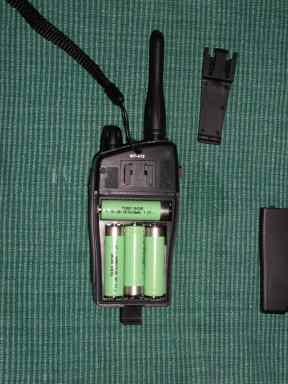
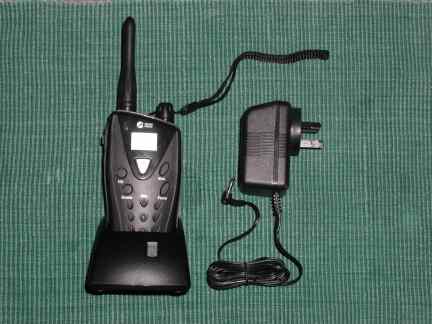
4 1600 mAH NiMiH rechargable
cells
radio in supplied charging base with pwr pack
AS-419 Single Charging Stand Operation
Flow
Indicator
Definition:
Indicator Condition
Status_____________________
Red
LED on
Charger Power On
Green
LED on & Blinking
Charging
Green
LED off & Remain Red LED on
Complete Charging
Operation
1.
Plug in the adapter into the AC outlet and connect to the single charging
stand.
2.
The red LED indicator of the charging
stand will light up; indicating the power of the charger is on.
3.
The single charger can only charge a single unit.
4.
Insert the rechargeable batteries into the 2-way radio.
5.
Put the 2-way radio into the single charging stand, the green
LED (on the charging stand) lights up and blinks (every 5 seconds) stating that
the unit is processing the charging mode.
6.
The green LED will be off and the red
LED will remain when the 2-way radio is fully charged.
7.
Complete charge time is around 7 to 8 hours.
see
bottom of page to use "alternative brand" Nickel
metal Hydride batteries in this radio
VEHICLE CHARGING
ADAPTER:
(car/motorcycle)
Unfortunately , you cant charge
the radio and talk on it at the same time .. however it can be charged off a 12
Volt only ( NOT 24 Volt) negative earth cigarette lighter socket , We
have a charging cable to do this with a 3.5mm stereo plug on the end . (ask us about
this !! ) $NZ 15.00
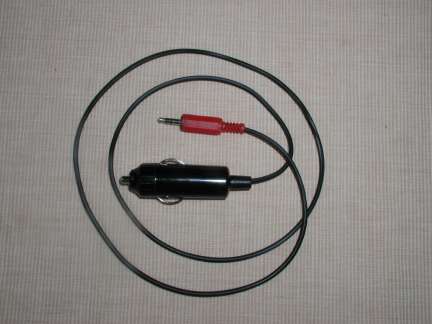
see also our
wt432 ($50)
and SP808 ($80) walkie
talkies
Notes: Re Aust/NZ standards for UHF CB
( AS/NZS
4365- 1996,)
Channel 22 and 23 are
reserved for Telecontrol and data only, these channels have been blocked
to comply with the Australian regulations . (you still have 38 to choose from
!!) BUT! see below
The
NEW shipment (Dec 2006) of WT419 is able to be opened on the blocked
channels in the hidden menu as shown below ! ! !
Press
"PTT", and the "CALL" key simultaneously and
rotate the volume key at the same time and wait for 3 seconds to turn
on the unit. "0000" will display.
Press
"Up" or "Down" key to go to "Au22" menu and then
press "Enter" key.
Press
"Up" or "Down" key to select "On" or
"Off".
Press
"Enter" key to confirm and back to "0000" display.
Press
"Enter" key to go back to normal display.
Channels 5 and 35
may not have CTCSS or calling function ( CTCSS and Calling tones are
blocked on these radios)
This is not a New Zealand Requirement
but since this product is registered for sale in the large Australian Market , the
Tone call cannot be activated for more than 3 seconds in any 60
second period ie you can tone call once but have to wait 60 seconds
before you can call again.
Water Ingress
If you ever drop a cell phone or walkie talkie into the water you must take
out the batteries as soon as you possibly can, as if there is any
electricity floating around on a wet circuit board ,electrolysis will begin to
eat away at the copper connections and dissolve them , electrolysis
will chew away the pins on integrated circuits and IN AS LITTLE AS 30 MINS
and the appliance will be rendered unfixable! Take those batteries out
pronto! and before you pull the device to bits to dry it out. In fact if you
drop a cell phone or radio into sea water, pull out the batteries immediately , then
dump the wet appliance into fresh water and give it a good soaking to dilute the
salt contamination off the circuit board and components ( you cant make things worse by
trying this , a radio has a much better chance of going again if its had
freshwater contamination than if it was dried out after salt water
contamination as the salt residue can short circuit connections!)
Performance:
I have done some electrical tests on it to assess its performance and I am quite impressed.
In this test I used a 5.7Volt power supply
as a voltage source. On receive it seems to trickle along at about 70mA
squelched and 90 mA un-squelched at easy listening volume, Though I suspect it
probably has a low power receive standby mode which it drops to after a time of
inactivity . The menu selectable mute opens at a very respectable -125 dBm ( close to the
lowest RF output on my HP8656b signal generator) there is a facility to
have two squelch settings 1, opens at -119dBm and 2,( more sensitive) opens at -125 dBm, I have measured the RF output using the Agilent
E3304B spectrum analyser and found +27 dBm (500mW) on low power and
+33.25 dBm (2W) on high power so it has quite a useful range
of output .
You can immediately double the range by switching from 500mW up to
2W ( it requires a 6dB ( four times) increase in power to double
the range on a transmitter and get the same received signal strength at
the other end ) There is a price to pay with a high powered radio and that
is current consumption. Low power was 300 mA and High power was 1200 mA hence
the need to supply rechargeable 1600mAh NiMHi cells as standard. The
handbook quotes a useful operating time as 13 Hrs continuous on a 5%transmit 5%
receive 90% standby time scale , recharge time to full capacity is 7 Hrs
. I have not equated this to user time in days while riding before having
to recharge. Always have 4 new AA alkalines with you in case you have the
misfortune of flattening the rechargeable batteries half way through a ride ,I
suggest you upgrade these cells to 2400mAh to maximise talk time at the 2 W
level , dont forget to peel the plastic off the negative end of the horizontal
battery !!
The rubber buttons on the front are not too small and I do like the fact it has
a volume control on the top and not the usual menu selected volume push button
system . Although in the model I assessed, I found the audio output level to the
earphone being somewhat lacking in volume , I think the manufacturer may
have deliberately padded down the earphone volume so as to not blow up the
earphone or users ears ! ( turns out they did !I have seen the
circuit diagram but I have asked that our shipment have the appropriate
series resistor removed so that there will be adequate volume in the
motorcycle headset !) all have since been modified at production time .(
I have tested the new modified model and it can be very loud so be careful !)
Note : If you are going to use an external speaker on this radio then it MUST
have a resistance of more than 16 ohms or the audio out put will be distorted
! (But not a problem in the shipment late Dec/Jan 2006 as the
resistor is inside the radio !! )
Technical Description : under construction
Select the wanted function by stepping through the LCdisplay options ie
Ch, channel . Cod Subtone code number. Sca, Scan all
channels. Sq squelch level setting . Vot Vox ,select
three sensitivity levels. Mon , disables squelch
settings . ton , calling tone selection. Pow , power
setting lo= 0.5 W Hi= 2.0 Watts . Rog ,end of over Beep,
off-on. Pof time selection for auto switch
off.
Select the required option , press the triangular Enter button ,
change the parameter using the up/down buttons, then confirm the
selection by pressing the Enter button again.
Problems solving "
Quite a few people ring up saying their radios dont go.( wont talk to each
other) and they are usually half right BUT also half wrong . Most of the
time the problems are best described as "Finger Trouble"
provided it has had an overnight charge and the radio is not giving "double
beeps " indicating a flat battery, then it is usually one or two things .
Read the manual thoroughly and follow its setup instructions . We find two major
problems providing both of the radios are on the same channel ie
Ch 01 ,
1. both radios must have
the same CTCSS sub-tone number eg 22 ,33, 01 what ever
, the CTCSS is an additional selective setup so only radios with the
same sub-tone (1-38) number will respond to each other ,
or disable it by selecting ctcss sub-tone 00 .
2. Make sure the Function
button has not switched on the Repeater function ,( small round
ring with a dot in the centre appears on the LCD display top Right hand
corner.) This repeater button only works for the first 8 channels ,
when you press the PTT button , you will see the display change to a channel
number in the 30's range ,this is the repeater shift . Necessary to work
through a repeater to boost range but the two radios will not talk to each
other if this function is enabled. turn it off ( dot with circle on LCD
gone ) .
Range: This is the million dollar question , Range in UHF radios
is usually quoted under optimum conditions ie Line of sight ,
unobstructed pathway between the radios . In fact with most small 500mW
walkie talkies ie 40 ch UHF radios ,their unobstructed range
is quite phenomenal ie top of Mnt Taranaki through to Mnt Ruapehu
providing its line of sight would be no problem . However, get these radios
down at ground level and other factors come into play , Signal absorption by
bushes ,trees , foliage, long grass all soak up precious signal and also
reflections off the ground out in front of the user can cause interference of
signals , all adding to reducing range. You could be getting 8 Kms at a
pinch out in the open plains and with the same radios in dense bush have a
problem communicating 500m !! Keeping the radio in your pocket up
close to the body will shield the radio from receiving signals ,If practical,
they are best left sitting up high somewhere where their antenna has a
good all round "View" , Don't forget to pick up the radio before you
move away !!! Use of the loud warbling "tone Call button" is beneficial in
these circumstances , if the radio is not immediately close to your ear . Sometimes, if the signal is a bit scratchy, reception can be
improved by listening to the radio held as high above your head as possible to
try and improve the received signal. UHF signals do not bend over
hills, hence if you are only half a kilometer apart with a high hill between
you, the signals may not bend over and flow down to the other radio and you may not
have contact, however if you are in a large mountainous valley,
you may find the signals bounce around and you may be surprised as to
where you can communicate! .
It is best to use the radio on its lowest power setting 0.5W, this is much
easier on batteries , when you switch to high power (2 W) the transmitter
really sucks up the power and your batteries will not last too long, (
depending on how long you actually talk for) so if you can talk on 0.5 W,
use it . Note, switching from 0.5W to 2 W will double your effective
communication range given the rest of the variables remain constant
. ( but flatten the batteries 4 times faster!)
Communication range is just so variable .
Price : ?? new stock , due to
currency fluctuations ,increase transportation the price is now NZ
$100 each plus postage ,which
is still well under any 2Watt handheld on the market!! and it comes supplied with
rechargeable batteries! (NOTE: due to the
variation in performance of NiMiH batteries , the batteries will NOT have a
warranty )
but it will require its own
motorcycle headset
plug!! and we have 0rdered 300 motorcycle headsets to suit, yes another bloody headset
connector change ! why
cant you manufacturers standardise!
Vehicle charging adapter for 12volt negative earth
vehicle $NZ15.00
Warranty
The WT419 will have a 6 month warranty for the radio, base charger , and wall
plug power supply. The warranty covers electrical defects only , and not
mechanical breakages . If there is signs of neglect ,water damage ,
misuse, unauthorized tampering , the warranty will be null and void . However we
are happy to honor this warranty if for some reason the radio fails ( we just
give you another one !!) ! we will not provide a
warranty on the rechargeable batteries in fact we are tempted
to sell the radio without rechargable cells and it would still be a very
inexpensive 2W radio !!
Using
Alternative Brand
Nickel
Metal Hydride
Batteries in this
radio
On no account try
to charge any other type of battery other than Nickel
Metal hydride batteries in this radio ,This
radio and its base/internal charger will only charge Nickel
Metal Hydride batteries safely , there is a
real risk of damage to the radio and possibly yourself should the incorrect type
of cells be overcharged and burst !! do not
try to charge Nickel cadmium, Alkaline ,or Carbon-Zinc cells.
There is a simple modification that needs to be done to only one of the
"other Brand" NiMH batteries and this battery will enable the
proper charging process (winking green light ) . Peel off the plastic
covering of one battery from the lower half only and this will
expose the metal case of the Nickel Metal Hydride battery. (see photos below)
Take the back off the radio to reveal the 4 batteries, remove the
batteries. If you look into the top horizontal battery compartment
without the batteries in place , you will see at the spring (-ve) end of the
battery contact and in the bottom/floor of that horizontal
compartment , at the conical spring end, a flat metal contact that pokes
up out of the floor and presses against the inserted battery case.
This is the "sensor" that tells the radio it has the original nickel
metal Hydride batteries in place.
note: The original green batteries supplied are missing the plastic battery
covering at the flat (negative) end of the cell . The sensor contact
in the horizontal battery compartment, detects this bare metal and tells
the internal charging circuit to initiate the charging process . If this contact
does not touch metal of the battery case ( ie there is still plastic
wrapping ) then charging is inhibited and no winking green light .
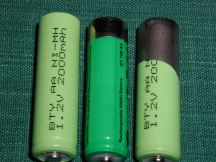
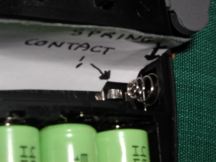
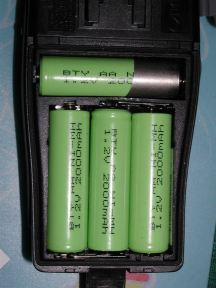
new , original, modified new. sensor contact to
enable charge modified cell in position
For those who are interested, the radio complies under AS/NZS
4365- 1996,
EMC Technologies (NZ) Test report No. 40603.1 dated 22 June
2004 , also
EMC Technologies ( Australia) SAR Test Report No.
MO40549 dated 11 June 2004 .
We also have the circuit diagrams as well !!
SEE MOTORCYCLE HEADSET
TO GO WITH THIS RADIO ( ignore
Uniden 041P
We offer a money back ( less postage ) guarantee with
all our products ( unless stipulated like batteries) , if faulty then we will
replace it or refund .BUT all goods must be returned in a saleable
condition ( boxes packaging radio unblemished so it can be resold as new
.). and you have 7 days to decide whether the radio will do what you
want ie potential, compatibility issues , range issues
etc Dont expect us to refund you after 2 months of use and the radio looks
like its well used and dirty ............ its yours !!
Want
to go back to Motorcycle
communications?
...... click here!
Pinfold Health Services Ltd,1172 Arawa st, Rotorua 3201,New Zealand. ph
+64-7-3488850 fax +64-7-3486555 pinfold@xtra.co.nz
return to CONTENTS
page







